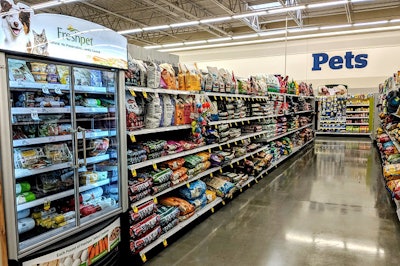
Online sales of pet food and treats in the U.S. reached U.S.$4.3 billion in 2018, representing a 45 percent increase year over year. That’s according to data from Nielsen shared in a recent webinar, “Top pet food trends in 2019.” The online sales accounted for 16 percent of the $26.8 billion U.S. pet food and treats market last year, which also included U.S.$8.1 billion sold in the pet specialty channel (30 percent market share) and U.S.$14.4 billion in all other channels (AOC) excluding veterinary clinics and convenience and farm/feed stores (54 percent share).
Though the other channels currently have higher sales and shares than e-commerce, that 45 percent growth rate stands out, especially compared to only 0.6 percent for pet specialty and 2.4 percent for AOC, according to Maria Lange, client director for Nielsen, who co-presented the webinar with Lindsay Beaton, managing editor of Petfood Industry. Actually, considering that pet food is competing for shelf space and dollars with so many other types of consumer packaged goods in the mass market/AOC channel, 2.4 percent growth isn’t bad and probably is due to “mass premiumization” of pet food – but it’s nowhere close to 45 percent.
Online pet food sales: a rising tide
Brick-and-mortar retailers, whether in pet specialty or AOC, might beg to differ, but e-commerce growth seems to be a “rising tide lifts all boats” driver, at least in terms of overall pet care and pet food sales in the U.S. “What is surprising is that online shopping has been not just cannibalizing existing business but delivering incremental sales growth,” said David Sprinkle, publisher and research director for Packaged Facts. “For the past few years, the internet has been disproportionately responsible for helping to keep the U.S. pet industry on a healthy upward track.”
Beaton presented Packaged Facts data during the webinar, showing that e-commerce, especially Amazon and Chewy.com, had a 17 percent share of U.S. pet food sales in 2017, compared to 20 percent for pet specialty and 20 percent for mass market retailers like Walmart and Target. The difference between those and the Nielsen figures likely owes to each market research firm including different channels and outlets in its data, plus that Packaged Facts included only cat and dog food and not treats or other pet species.
Natural and grain-free pet food sales rising in mass market
In her part of the webinar, Lange focused on brick-and-mortar pet food sales and the impact of the rapidly changing retailing scene, including mass premiumization. For example, sales of natural pet food in AOC including convenience stores reached U.S.$2.5 billion in 2018, nearly doubling 2015 sales of U.S.$1.3 billion. Similarly, grain-free pet food in the same outlets hit U.S.$1.1 billion in 2018, rising dramatically from just U.S.$0.4 billion in 2015.
It’s worth noting, as Lange did, that the recent concern over grain-free diets linked to atypical cases of canine dilated cardiomyopathy (DCM) has not seemed to affect pet retail sales: grain-free growth had been slowing even earlier last year, before the Food and Drug Administration issued its DCM alert in July, yet was still at 8.6 percent for the year. At the same time, the products’ velocity, or sell-through per pet retail store, remained steady at an average of U.S.$30,000. Sales hit U.S.$3.7 billion in 2018 for a 46 percent share of the pet retail market, and the number of new grain-free products launched also increased in 2018 to 60 percent of all pet food and treat launches in that channel, up from 54 percent the prior year.
Keeping pet specialty special
Despite the rise in the AOC channel of pet foods traditionally associated with pet specialty, the latter channel’s retailers still have opportunities to compete and “stay special,” according to Lange. Some of these retailers are beginning to see the benefits of having their own private label pet food lines, just as large mass market outlets have for several years. Sales of private label pet food in brick-and-mortar stores are now increasing at the same rate in pet specialty – 20 percent – as in pet retail overall, including AOC. Pet specialty sales, at U.S.$413 million in 2018, account for only 17 percent of the U.S.$2.4 billion in private label pet food for pet retail overall, but the specialty channel is starting to catch up.
Lange advised that pet specialty retailers should continue to ride trends such as private label and grain-free, plus mixers and meal enhancers or toppers. Of the 3,485 new pet food and treat items launched in pet retail in 2018, 8 percent were meal enhancers, she said, up from 4.2 percent in 2016. Though accounting for only 1.2 percent of the U.S. pet retail market, their sales rose 28 percent year over year, reaching U.S.$100 million in 2018.
Other risers in terms of product launches included limited ingredient diets (8.3 percent, up from 6.8 percent), frozen meals (3.7 percent, from 2.9 percent) and 100 percent dehydrated meals (3.3 percent, up from 1.8 percent). Holding steady were natural pet foods at 77 percent and 100 percent freeze-dried meals at 2.7 percent.
In terms of sales, trending products all enjoyed increases in 2018, according to Lange:
- Kibble plus – U.S.$400 million in sales, 20.5 percent growth and a 4.9 percent market share;
- Frozen – U.S.$136 million, 15 percent growth and 1.4 percent share;
- Freeze-dried (full meals) – U.S.$112 million, 20 percent growth and 1.4 percent share;
- Dehydrated (full meals) – U.S.$56 million, 23.7 percent growth and 0.7 percent share.
Other opportunities for pet specialty retailers to compete against e-commerce and the AOC channel include convenience, experience – Lange mentioned food kitchens, dog washes and other services and experiences that can only be offered in a physical location – and transparency.
















